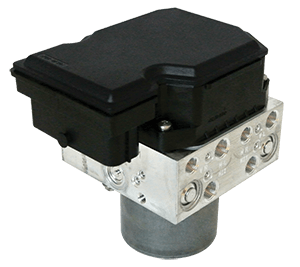What is an ABS system and how does it work in a car?
The ABS unit is a system that was first used in a Formula 1 car in the 60s. Roughly 60 years later, we can no longer imagine new cars without a anti-lock braking system. In fact, an ABS system is now obligated with the development of new cars and motorcycles. Even the first e-bikes have now been equipped with an ABS system. But how does such an ABS computer actually work and how does it reduce the number of accidents?
The advantage of ABS compared to the past
As the name ABS (anti-lock braking system) suggests, the ABS ensures that the wheels of a car can't lock-up. Especially when braking on bad roads or in bad weather, the chance of a locked-up wheel is increased due to the reduced grip. When the wheels lock, this obviously has a major effect on the braking distance. On a dry road surface, the braking distance is about 10% longer than on a car with an ABS system, while under rainy conditions the braking distance can even be 30 percent longer!
How does an ABS system work?
An ABS system actually does nothing else than make a "pumping" movement when one or more of the wheels threatens to lock during braking, causing the wheel to continue rolling. Exactly what you want to shorten the braking distance! To achieve this piece of ingenuity, an anti-lock braking system has three components that together form part of the ABS system. These parts are the pump motor, the HCU and the ABS ECU.

Pump motor
As mentioned, the ABS unit provides a pumping movement towards the caliper, so the wheel cannot lock-up. This is a very fast process that is repeated dozens of times per second. The pump motor of the ABS system ensures that pressure is maintained on the brake system. This pressure is needed when the ABS unit intervenes to make the pumping movement.
HCU
The HCU stands for "Hydraulic Control Unit". The HCU is an aluminum component with various valves and channels. When the ABS intervenes, it is important to relieve the pressure that the system builds up by braking a wheel. This is done via the valves. Furthermore, there are various actuator pins on the HCU that can open and close the channels in the ABS.
ABS ECU
Where a "normal" ECU is for the engine, the ABS unit is for the anti-lock braking system. Based on data from, for example, the wheel sensors and pressure sensors, the ABS ECU determines whether the ABS should actually take action. As soon as the ECU picks up a "wrong" value, the pump motor is triggered to take action.
ABS with ESP
In addition to the conventional ABS system, more and more units use ESP, which stands for Electronic Stability Program. While ABS ensures that the wheels do not lock during braking, ESP ensures that the car actually goes in the direction that the driver wants. When the car suffers from understeer or oversteer, the ESP functionality brakes one or more wheels, so that the car goes in the right direction. ESP therefore ensures stable driving behavior in all driving directions. Examples of ABS units that use ESP are the ATE MK26 ESP and the Bosch 8 ESP. Thanks to ESP's major safety benefits, all new cars since 2014 are obligated to have ESP functionality. ESP provides various studies, namely for around 30% fewer one-sided accidents.

 da
da de
de es
es fr
fr it
it nb
nb nl
nl pt
pt sv
sv fi
fi